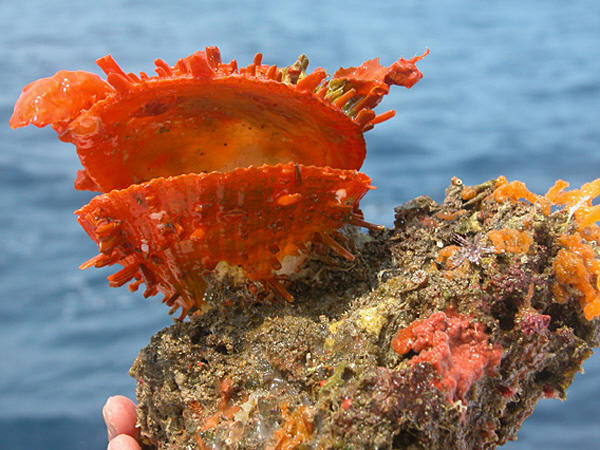Oyster
The name Oyster is used for a number of different groups of mollusks which grow for the most part in marine or brackish water.
| Table of contents [showhide] |
|
1 True oysters |
True oysters
The "true oysters" are the members of the family
Ostreidae, and this includes the edible oysters, which mainly belong to the genera Ostrea, Crassostrea, Ostreola or Saccostrea. Examples are the Edible Oyster, Ostrea edulis, the Olympia Oyster Ostreola conchaphila, Wellfleet oyster and the Eastern Oyster Crassostrea virginica. Oysters can be canned, eaten raw or cooked. When caught, like all shellfish they have an extremely short shelf-life. They should be fresh when consumed or serious illness can result. Additionally, oysters can host various illness-causing pathogens. Therefore, consumption of raw oysters should be done with caution. Researchers in Oregon have invented a self-shucking oyster. thumb|250px|Oyster for Christmas celebrationPearl oysters
Although all oysters (and, indeed, many other bivalves) can secrete pearls, those from edible oysters are commercially valueless. The Pearl Oysters come from a different family, the Pteriidae (Winged Oysters). Both cultivated and natural pearls are obtained from these oysters, though some other mollusks, for example freshwater mussels, also yield pearls of commercial value.
Other molluscs named "oyster"
A number of other molluscs not falling into either of these groups have common names that include the word "oyster", usually because they either taste or look like oysters, or because they yield noticeable pearls. Examples include:
| the family Spondylidae, the Thorny Oysters; | |
| the Pilgrim oyster, a kind of scallop. |
External link
| Family tree of Molluscs | |
| WikiBooks: How to cook oysters |
Spondylus (Thorny Oyster)

| Thorny Oysters | ||||||||||||||
|---|---|---|---|---|---|---|---|---|---|---|---|---|---|---|
| Scientific classification | ||||||||||||||
|
||||||||||||||
| Species | ||||||||||||||
| many; for examples see text | ||||||||||||||
Spondylus is a genus of bivalve molluscs, the only genus in the family Spondylidae. As well as being the systematic name, Spondylus is the most often used common name for these animals, though they are also known as Thorny Oysters. There are many species of Spondylus, and they vary considerably in appearance and range. They are grouped in the same superfamily as the scallops, but like the true oysters (family Ostreidae) they cement themselves to rocks, rather than attaching themselves by a byssus. Their key characteristic is that the two parts of their shells are hinged togehter with a ball and socket type of hinge, rather than a toothed hinge as is more common in other bivalves. Spondylus have multiple eyes around the edges of the shell, and they have a relatively well developed nervous system. Their nervous ganglia are concentrated in the visceral region, with recognisable optic lobes, connected to the eyes. Spondylus shell are much sought after by collectors, and there is a lively commercial market in them. Some typical species are:
| Wright's Thorny Oyster, Spondylus wrightianus | |
| Japanese Spiny Oyster, Spondylus japonica | |
| Pacific Thorny Oyster Spondylus princeps | |
| Atlantic Thorny Oyster Spondylus americanus | |
| Regal Thorny Oyster Spondylus regius | |
| Nude Thorny Oyster Spondylus anacanthus | |
| European Thorny Oyster Spondylus gaederopus | |
| Spondylus versicolor | |
| Spondylus tenellus |
External links
| Information about Spondylus from the website of the Gladys Archerd Shell Collection at Washington State University Tri-Cities Natural History Museum |